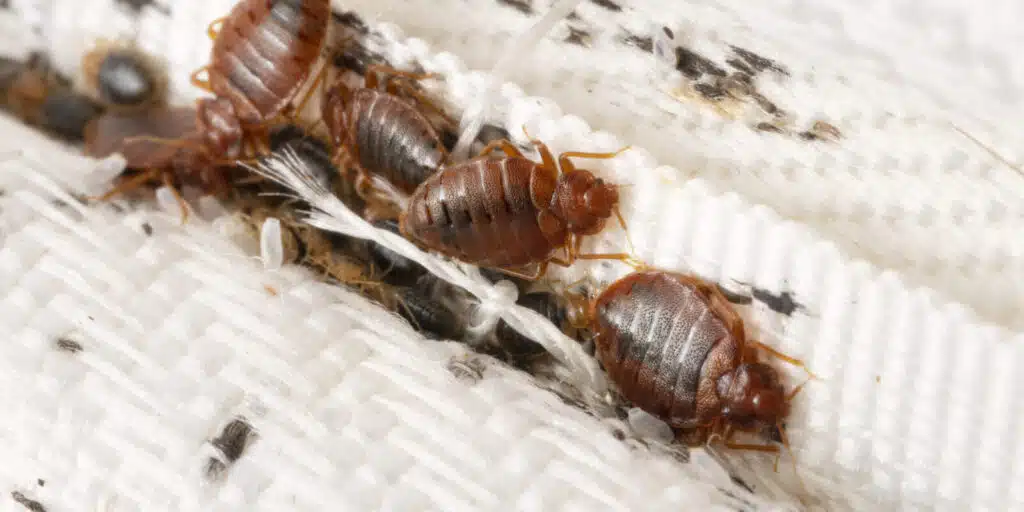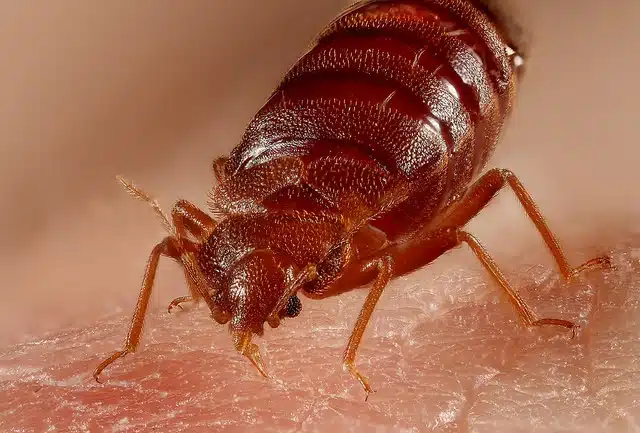

Many people believe that there is a link between having a bed bug infestation and poor hygiene. This is not the case. Having a bed bug problem is not linked to a lack of cleanliness – bed bugs can be found in the cleanest homes and even luxury hotels.
Read on to find out more about bed bug infestations, their favourite hiding places, and how pest control companies can help you if you find your home or business overrun with these small insects.

Bed bugs have several means of travel. They can crawl from one area to another or they can cling on to clothing or luggage and be transported that way. They are also quite good at moving through cracks and crevices. This allows them to infest multiple areas within a building quickly and without people noticing.
Bed bugs can easily travel between rooms or units in multi-unit dwellings, such as flat and apartment buildings, through shared walls or pipes. Their ability to move quickly and inconspicuously makes it challenging to detect and control their spread. Bed bugs do not have wings and are unable to fly. However, they have found clever ways to travel long distances and infest new areas.
You should take precautions such as regularly inspecting for signs of infestation. This helps to prevent the spread of bed bugs. Bed bugs can detect human presence through the carbon dioxide we exhale. This is what helps them to locate potential hosts to hitch a ride with.
Bed bugs often find their way into homes by hitching a ride on everyday items. The most common sources include luggage after travelling, second-hand furniture, clothing, or even visitors who have unknowingly been exposed. They can also move between adjoining flats or hotel rooms through wall voids, pipes, and electrical outlets. Once inside, bed bugs quickly spread to warm, hidden areas such as mattresses, bed frames, and upholstered furniture. Because they’re expert hitchhikers and can survive for months without feeding, even a single bed bug can lead to a larger infestation if not treated promptly.
A common misconception is that bed bugs are attracted to dirt or poor hygiene, but this isn’t true. Bed bugs are drawn to warmth, body heat, and the carbon dioxide we exhale, not to unclean environments. Even spotless homes, hotels, and offices can experience infestations if bed bugs are accidentally introduced through luggage, clothing, or furniture. They thrive anywhere people rest or sleep, making hygiene levels largely irrelevant to their presence. The key to preventing and removing them is early detection and professional treatment, such as bed bug heat treatment, which eliminates bed bugs at all life stages without relying on chemicals.
Bed bugs are hitchhikers. If you visit a place that has them, they may hitch a ride on your luggage or get into your clothes. Bed bugs are attracted to body warmth because they know this means blood. They can be found anywhere humans are, however there are places where you are more likely to find them:
Places like hotels, hostels, and bed and breakfasts can easily become overrun with bed bugs. The same can be said for AirBnBs and cruise ships. With so many people coming and going and sleeping here, it is no surprise that you can find bed bugs here, too.
Bedbugs love to hide near where people sleep. Visitors or houseguests can unknowingly bring them to your home. Similarly, you may not realise that you have been somewhere that has an infestation and the bugs can travel home on your clothing. You can even bring bedbugs into your home on used furniture – be sure to thoroughly inspect any second-hand furniture before you bring it into your home!
If you live in a flat and a neighbour has an infestation, you may find that your home and the common areas of the building are quickly overrun.
There may be infested areas in businesses, too. If a coworker has an infestation at home, they can unknowingly bring them to work. Conversely, you can unknowingly bring bedbugs home with you from work, too.
Public transport gets a lot of traffic each day. Transportations such as buses, planes, trains, and taxis can all hide bedbugs if someone has unknowingly brought them on board.
Bed bugs are attracted to warmth and carbon dioxide emitted by sleeping humans, often congregating in and around beds. The first sign of bed bugs is often itchy bedbug bites on the skin. You may notice red, irritated itchy spots of skin of an allergic reaction. Other signs are:
1.) Blood spots on sheets or soft furnishings
2.) Dark bedbug excrement on mattresses or walls
3.) Shed skins and eggshells around hiding places
4.) A musty odour in infested areas
Yes. Bed bugs can survive for months without feeding. They remain dormant until they find a suitable host. This makes them difficult to eliminate, as they can hide in cracks, cracking paint, and other furniture for long periods.
Unlike some human pathogens, bed bugs are not known to spread disease. However, their bites can cause severe itching and allergic reactions. This can lead to skin infections if scratched excessively.
If you suspect a bed bug infestation, act fast. The sooner you address the issue, the easier it will be to remove bed bugs and prevent a larger bed bug problem.

The only reliable way to eliminate bed bugs completely is through professional treatment. At ThermoPest, we use advanced bed bug heat treatment to kill bed bugs at every life stage — eggs, nymphs, and adults — in just a single visit. Unlike DIY sprays or home remedies, our thermal process reaches deep into mattresses, furniture, and hidden cracks where chemicals can’t.
If you’ve noticed signs of bed bugs, it’s important to act quickly. Avoid moving infested items between rooms or attempting over-the-counter sprays, as these can make the problem worse. Instead, contact ThermoPest for a fast, discreet inspection and complete heat treatment solution. Our experienced technicians provide a 60-day guarantee and tailored guidance to ensure your home or business stays completely bed bug-free.
In summary, bed bugs are primarily caused by human-related activities that allow them to travel and establish themselves in new locations. The main causes include:
Hitchhiking on clothing, luggage, and personal belongings during travel
Infested second-hand furniture or soft furnishings
High-traffic public spaces such as hotels and public transport
Spread between units in apartment complexes or multi-unit buildings
Understanding these causes can help you take proactive steps to prevent bed bug infestations, such as inspecting accommodation when travelling, carefully checking second-hand furniture, maintaining cleanliness, and seeking professional pest control assistance promptly if you suspect an infestation.
Do you think you may have a bed bug infestation at your home or business? If so, it is very important to act quickly. A single bed bug can live up to a year and can lay over 500 eggs in this time.
Bed bug treatments will always work best when infestations are detected early and permanently eradicated.
We will always recommend contacting a professional company for bed bug treatments rather than DIY treatments to ensure complete eradication.
Do you have an infestation? Contact us today to speak with our team
Leading experts in bed bug control
Guaranteed quick and rapid responses to urgent infestations
For ongoing problems, use our preventative contracts
Yes. Shared living spaces with frequent turnover are prime environments for infestations to spread.
Bed bugs move through walls, floors, and electrical conduits in flats and terraced housing.
Call us on 0808 189 2310 – or complete our quote form below.
Speak to a bed bug expert today!
Enter Your Details To Request A Call Back
Enter Your Details To Request A Call Back
Enter Your Details To Request A Call Back
Enter Your Details To Request A Call Back
Enter Your Details To Request A Call Back